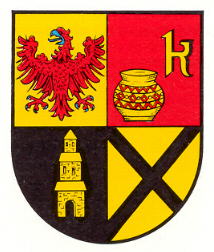Kleinsteinhausen: Difference between revisions
Jump to navigation
Jump to search
Knorrepoes (talk | contribs) m (Text replacement - "|'''English''' ↵| {{blazon wanted}}↵" to "|'''English''' | blazon wanted ") |
Knorrepoes (talk | contribs) m (Text replacement - "↵{{de1}}↵{{media1}}↵↵'''Literature''': Debus, 1988↵↵[[Category:German" to " '''Literature''': Debus, 1988 {{de1}} {{media1}} [[Category:German") |
||
| Line 24: | Line 24: | ||
The eagle and cross are taken from the arms of the medieval Lords of Ettendorf, who ruled the villages of Gross- and Kleinsteinhausen. The second quarter shows an urn for the many Celtic artifact that have been found in the village, as well as the letter K for the village. The third quarter shows a canting stone house (Steinhaus) and refers to the Stainhäuser family from the village. | The eagle and cross are taken from the arms of the medieval Lords of Ettendorf, who ruled the villages of Gross- and Kleinsteinhausen. The second quarter shows an urn for the many Celtic artifact that have been found in the village, as well as the letter K for the village. The third quarter shows a canting stone house (Steinhaus) and refers to the Stainhäuser family from the village. | ||
[[Civic Heraldry Literature - Germany|'''Literature''']]: Debus, 1988 | |||
{{de1}} | {{de1}} | ||
{{media1}} | {{media1}} | ||
[[Category:German Municipalities K]] | [[Category:German Municipalities K]] | ||
Revision as of 09:24, 21 July 2023
KLEINSTEINHAUSEN
State : Rheinland-Pfalz
District (Kreis) : Südwestpfalz
Verbandsgemeinde : Zweibrücken-Land
| German | No blazon/translation known. Please click here to send your (heraldic !) blazon or translation |
| English | blazon wanted |
Origin/meaning
The arms were granted on June 17, 1982.
The eagle and cross are taken from the arms of the medieval Lords of Ettendorf, who ruled the villages of Gross- and Kleinsteinhausen. The second quarter shows an urn for the many Celtic artifact that have been found in the village, as well as the letter K for the village. The third quarter shows a canting stone house (Steinhaus) and refers to the Stainhäuser family from the village.
Literature: Debus, 1988
